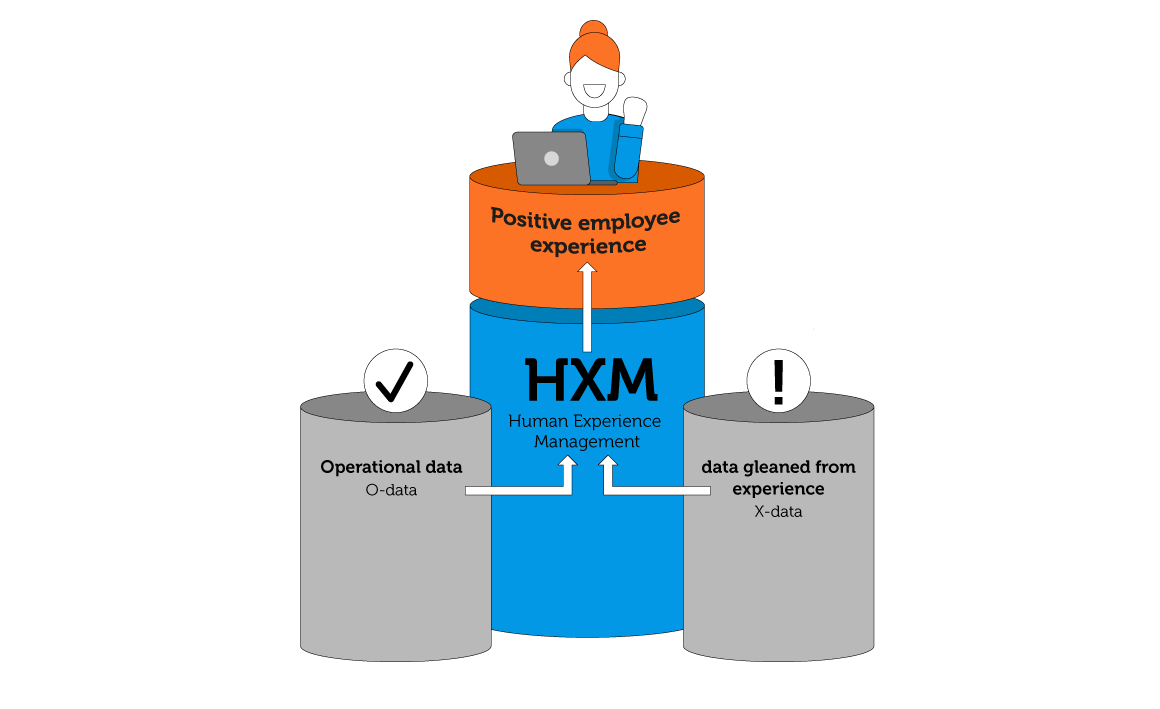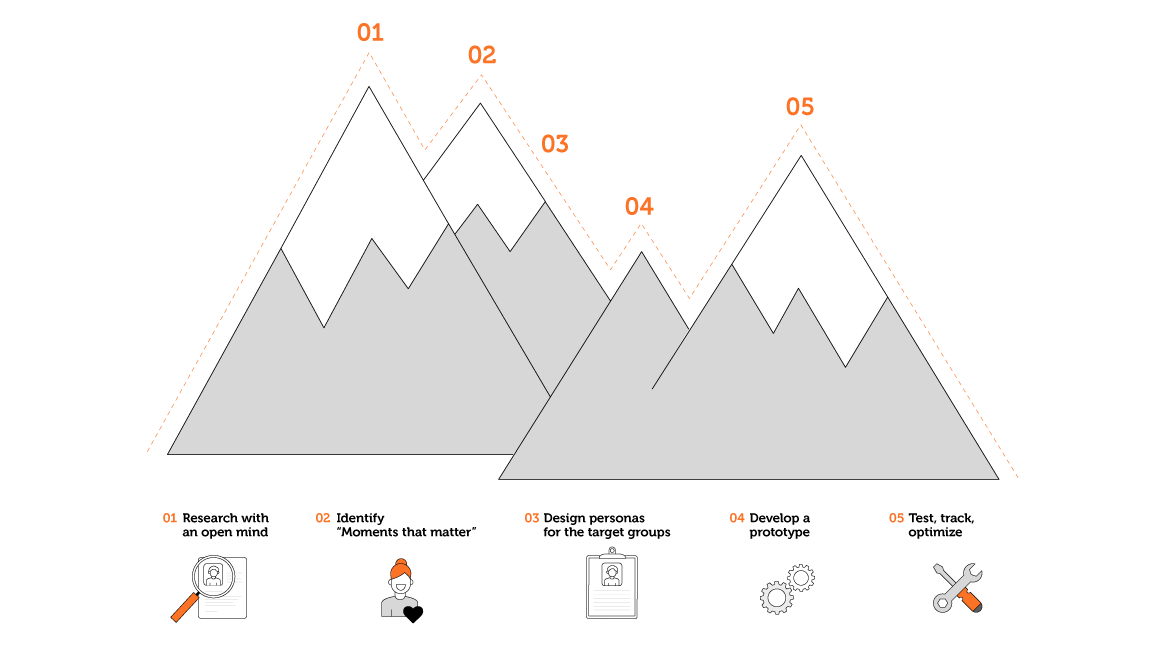Employee experience – the X-factor in the workplace

Headset on ready to dive into the next team meeting, responding to a couple of emails while they’re at it, straightening out some issues with the new project, and then – just before they clock off – carefully putting together their to-do list for the next day so they can get straight down to work in the morning. It’s probably fair to say that this is the image most bosses and HR managers have of the ideal employee – committed, bursting with inspiration and conscientious. In reality, these heroes of the workplace tend to be the exception rather than the rule. Apparently, what is on most employees’ minds as the working day draws to a close is not what they have to do the next day but how to survive in their performance limbo.
Going through the motions in the motivation black hole
This may sound extreme, but several recent studies have shown that employees are experiencing more frustration than motivation at work. For example, the latest Gallup State of the Global Workplace report comes to the sobering conclusion that 85 percent of the employees surveyed in 155 countries are unmotivated when they start their working day. Of these 85 percent, 20 percent have already lost all emotional attachment to their companies and have quit in their own minds. This is especially true in Germany, which tops this particular list in the Employee Expectations Report 2020 from Peakon, with 23 percent – in no other country in the world are people so lacking in motivation when they go to work.
The financial consequences of this are disastrous. Peakon estimates that companies with 10,000 employees have to bear costs of more than 48 million euros because unmotivated staff are more likely to quit than motivated staff and twice as likely to call in sick. The figures from Gallup tell a similar story, estimating the global cost associated with a lack of motivation to be around seven trillion dollars a year – that’s about 6,000 billion euros. Just think of all the ways that money could be better spent!
HR at a crossroads
At least part of this money could be plowed into a new evolutionary development of HR in the future, because as these recent studies indicate, traditional HR methods are no longer up to the job. One reason for this is the digitalization of HR – or more precisely, the software being used for this. An unfortunate trend has emerged since the first digital systems for human capital management (HCM) were introduced. Due to the processes and functionalities mapped in these systems, employees have ultimately come to be seen as just another resource to be quantified, managed and replaced like any other, from recruiting, through talent management right up to succession planning.
There’s no doubt that any HR department can now use the data collected about the workforce to monitor the staffing situation in the company effectively and take action when developments start heading in the wrong direction. However, all this data says nothing about the attitude individual members of staff have toward their work and how they feel about it. From a system perspective, lifecycle management is still primarily aimed at meeting the HR department’s resource management requirements. As a result, HR staff are experts in efficient processes, standardized workflows and low admin costs, but know little about the actual wishes and needs of employees. This has previously not been a priority.
Human experience management as a motivation booster
The only problem is, working to rule is now far from sufficient to keep up with today’s dynamic and global competitive environment. Success these days equates to outstanding performance. Achieving this takes creative, committed employees who are focused on service, feel valued and can realize their full potential.
This is where “human experience management” comes in.
Unlike conventional human resources, modern human experience management, or HXM, focuses on the wishes, experiences and emotions of staff. Attentive, constant listening, continuous two-way feedback, deliberately shaping positive experiences throughout the employee journey at the “moments that matter” – all these strategies aim to boost motivation and ensure stronger identification with the aims of the company.
From an HXM point of view, employee satisfaction is just as important for the success of the company as customer satisfaction. In other words, when it comes to corporate goals, customers and employees are equal stakeholders. This is also borne out by the Gallup findings. The companies that lead the way for employee experience (EX) enjoy an average of 20 percent more productivity, efficiency and sales than competitors with lower employee engagement.
X-data – the key to a positive employee experience
While this is nothing new, it becomes much more important in the hard-fought war for talent. Every HR department and every manager should therefore seriously ask themselves how they can improve the employee experience and establish a corporate culture that motivates and inspires people, binds them to the company and contributes to an outstanding performance.
A key foundation for this is having the right information based on data gleaned from experience – or, to use the new term for it, X-data. Unfortunately, most companies don’t have this data. Instead, they have traditional HCM systems filled with lots and lots of operational data (O-data) that they can use to analyze the success of employer branding, statistically relevant developments in the hiring rate, induction time, training, sickness levels and staff turnover.
Although this transactional O-data offers HR departments an excellent picture of what is happening in the company, it doesn’t tell them why. For this, they need X-data, which can be gathered using simple surveys or by getting specific feedback in situations that have a lasting influence on the employee experience – in other words, where it really matters.

Combining O and X data for a positive employee experience
Valuable findings by combining O- and X-data
Things get very interesting when O- and X-data correlate. By combining quantitative and qualitative data, companies can gain the information they need to identify completely new opportunities for positively shaping the employee experience, be that for individual employees or as part of a wider program.
For example, obtaining a holistic view of operational and experience data reveals how well-integrated new employees feel, what impression they have so far of the company, and what effect the respective status quo has on individual performance. What’s more, combined X- and O-data provide information about which experiences are decisive in making an employee stay or go. In addition, they also show how certain measures, such as less supervision and more decision-making freedom, the provision of popular digital tools, sustainable career support and regular discussions with the relevant manager, can influence the motivation and productivity of individual employees.
However, the most important thing is that analyzing combined X- and O-data helps companies identify very quickly where their ambitions and reality don’t match up. This means they can then efficiently and considerably improve the employee experience at key points.
Employee experience design – building a bridge between theory and practice
Of course, data forms an excellent basis for doing the right thing – especially if the data is good. When it comes to the employee experience, however, even the best data is of little use if the mindset is not right. To deliver a good EX, it is crucial to understand what the company and all its HR activities look like from the employees’ perspective. Seen from their point of view, employees are not resources to be managed, but rather people to be valued and rewarded, people who want to feel their work has meaning, people who want to develop both professionally and personally. So what exactly does this involve? The best answer to this question is – let’s find out! Just like the model it is based on (the customer experience), the starting point for the employee experience is understanding the expectations and experiences of the employees, so as to then improve them.
Various tools developed for customer experience management are also used in human experience management – research, analysis of all the critical experience touchpoints on the employee journey, use of personas and solution-oriented prototypes, and continuous tracking and adjustment of experience quality.
Without too much effort or expense, companies can use these tools to dip their toes into employee experience design and continuously improve the outcomes through feedback.

Five steps to Employee Experience Design
The key steps are:
- Research: Even the most creative solutions are of little help if nobody knows which solution really works. The HR department must therefore survey the company’s employees and listen carefully, rather than assuming that they already know the wishes and expectations of staff. Questions might include: How do you find working in your team? What do you aim to achieve? What do you need so you can become more productive? What would you wish for to make you enjoy your job more?
- Identify “moments that matter”: Instead of sprinkling little improvements all over, or promoting well-meaning statements of intent, the research phase should use various journey maps to identify the situations in the company that offer a particularly intensive experience quality or create a negative employee experience. One measure should then be prioritized that promises the greatest added value with little outlay and positively influences the employee experience.
- Develop personas for the target groups: Personas are fictional characters that represent various target groups. These profiles are frequently role-based and help to understand which wishes a target group has, the pressure it is under, the challenges it faces and what it needs to complete its tasks.
- Develop a prototype: From these lessons learned, it is possible to develop an initial, simple prototype whose sole purpose is to improve the quality of the experience in the selected “moment that matters”. This could be an app, a smart chatbot or another solution, and need not be perfect – all it has to do is serve its purpose.
- Test, track, optimize: In the course of several feedback loops, the prototype is thoroughly tested and gradually perfected until it lives up to the employees’ requirements. Not every individual opinion needs to be taken into account. The pragmatic compromise here is to accept the opinion of the majority.
Much more important than striving for perfection in employee experience design is the willingness to experiment. Companies should get active and start taking concrete steps as quickly as possible in line with the motto “are you working yet, or still planning?”. They should align themselves with the interests of employees – no ifs, no buts. When they can do that, nothing will stand in the way of a good employee experience.




